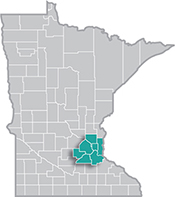 The Minneapolis-St. Paul metropolitan area is a national leader in finance, advanced manufacturing, agriculture and retailing.
The Minneapolis-St. Paul metropolitan area is a national leader in finance, advanced manufacturing, agriculture and retailing.
Medical devices, electronics and processed foods are strong suits recognized globally.
Want the freshest data delivered by email? Subscribe to our regional newsletters.
12/27/2021 9:00:00 AM
Tim O'Neill
January is Health Care Month in the State of Minnesota. Highlighting the importance of this industry this month is even more appropriate as we mark two full years since COVID-19 cases were first reported in the United States. During these past two years health care workers have been there to help treat and care for those stricken with the coronavirus, as well as all other ailments and injuries. This post will reveal the extreme need for health care workers, including support staff, to fill the record-high number of vacancies in this industry – vacancies that have greatly increased during the pandemic.
 According to the Department of Employment and Economic Development's (DEED) Job Vacancy Survey (JVS), employers in Health Care & Social Assistance reported more than 23,000 job vacancies in the Metro Area during the second quarter of 2021. There has never been a greater need for such workers in the region. In fact, the number of vacancies jumped by more than 35% (6,000 vacancies) between the previous record high in 2020 (Figure 1). Meanwhile, the job vacancy rate for this industry spiked recently to 8.7%. Essentially, this means that there are about nine job vacancies in Health Care and Social Assistance for every 100 filled jobs. Overall, Health Care & Social Assistance accounted for about one-fifth (19.3%) of the Metro Area's total 119,505 job vacancies during the second quarter of 2021.
According to the Department of Employment and Economic Development's (DEED) Job Vacancy Survey (JVS), employers in Health Care & Social Assistance reported more than 23,000 job vacancies in the Metro Area during the second quarter of 2021. There has never been a greater need for such workers in the region. In fact, the number of vacancies jumped by more than 35% (6,000 vacancies) between the previous record high in 2020 (Figure 1). Meanwhile, the job vacancy rate for this industry spiked recently to 8.7%. Essentially, this means that there are about nine job vacancies in Health Care and Social Assistance for every 100 filled jobs. Overall, Health Care & Social Assistance accounted for about one-fifth (19.3%) of the Metro Area's total 119,505 job vacancies during the second quarter of 2021.
With nearly 5,000 job vacancies, Home Health & Personal Care Aides had the most job vacancies of any health care occupation. Other specific health care occupations with high demand include Nursing Assistants, Registered Nurses, Licensed Practical and Licensed Vocational Nurses, Medical Assistants, Clinical Laboratory Technologists and Technicians, Psychiatrists, Physicians, Medical and Health Services Managers, Pharmacy Technicians, Pharmacists, Dental Assistants, and Radiologic Technologists and Technicians. Table 1 highlights a variety of in-demand health care occupations, along with related information on education requirements and typical wages.
Table 1. Select Health Care and Social Assistance Occupations in Demand, Metro Area
| Occupation | Total Employment | Q2 2021 Vacancies | 25th Percentile Hourly Wage | Median Hourly Wage | Typical Education Required |
|---|---|---|---|---|---|
| Registered Nurses | 38,340 | 2,712 | $35.78 | $42.44 | Associate Degree |
| Home Health & Personal Care Aides | 65,160 | 4,980 | $13.24 | $14.69 | High School or Less |
| Nursing Assistants | 11,110 | 3,023 | $17.36 | $19.35 | Vocational Training |
| Licensed Practical Nurses | 6,790 | 1,021 | $22.66 | $25.59 | Vocational Training |
| Medical Assistants | 6,080 | 649 | $19.37 | $22.28 | Vocational Training |
| Pharmacy Technicians | 4,990 | 239 | $16.55 | $19.78 | High School or Less |
| Clinical Laboratory Technologists & Technicians | 4,220 | 380 | $22.27 | $27.59 | Associate Degree |
| Physician Assistants | 1,480 | 98 | $54.48 | $60.70 | Graduate Degree |
| Pharmacists | 3,900 | 235 | $57.16 | $66.27 | Graduate Degree |
| Dental Hygienists | 2,720 | 165 | $35.12 | $38.12 | Associate Degree |
| Dental Assistants | 3,280 | 206 | $24.99 | $28.38 | Vocational Training |
| Physicians, All Other | 3,690 | 306 | $86.38 | >$100.00 | Graduate Degree |
| Nurse Practitioners | 2,420 | 174 | $54.25 | $59.81 | Graduate Degree |
| Massage Therapists | 1,070 | 23 | $15.84 | $27.95 | Vocational Training |
| Radiologic Technologists & Technicians | 2,250 | 201 | $29.45 | $34.73 | Associate Degree |
| Source: DEED Job Vacancy Survey, DEED Occupational Employment Statistics, DEED Educational Requirements for Occupations | |||||
The Health Care and Social Assistance industry has other vital occupations in high demand, too, including Medical Secretaries and Administrative Assistants, Receptionists and Information Clerks, Childcare Workers, Janitors and Cleaners, and Food Servers. With so many occupations in demand, the entry points and pathways of advancement in this industry are nearly endless. Visit DEED's Career and Education Explorer (CEE) or CareerOneStop to discover more, with both resources including links to job applications.
To learn more about Health Care Month in Minnesota, visit careerforcemn.com/HealthCare. This page includes resources for job seekers, students and educators and employers. For example, numerous hiring events and career fairs are happening throughout the month of January for those looking for work in the health care industry. Employers can also find additional resources for attracting, developing, and retaining talent online here.
Contact Tim O'Neill, Labor Market Analyst.